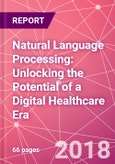The great struggle to digitize the business of healthcare and practice of medicine is over; however, the war to wrangle and analyze the data collected will rage on for years. In the rush to digitize and not unreasonably disrupt established clinical workflows and documentation practices, as much as 80 percent of the data captured by IT systems is unstructured, and the text is often poor quality. In its current format and given the high cost in human time and effort it would take to read, the extensive library of health data is effectively unusable. Thus, the quest to drive better healthcare decision making and analytics remains an unfulfilled promise.
Yet the need to leverage unstructured data is growing in importance as the business model for reimbursement of care shifts from fee-for-service to value-based care (VBC). Natural Language Processing (NLP), a subcategory of artificial intelligence (AI), has the ability to augment and automate human behaviors and skills. It can be used to parse and abstract key information from a variety of sources, such as clinician notes, thereby unlocking unstructured data and helping ease payers and providers through the transition to a new reimbursement model. This augmentation - leading to automation of such mundane tasks as quality reporting and creating patient registries among others - has the potential to save healthcare organizations (HCOs) significant money and time.
The current market for NLP technology in healthcare is nascent, dominated by a few legacy vendors that are focusing on front-end speech recognition (for computer-assisted physician documentation) and back-end coding (to optimize billing). While a number of tech giants continue to advance NLP technology for more general use, there are only a handful of niche solutions from highly specialized healthcare vendors pursuing additional use cases. We have outlined several of these vendors in this report. Many academic institutions are also developing their own solutions, often using open-source software. Such academic solutions offer the potential that joint ventures with vendors could lead to commercialization and potentially broader acceptance of NLP.
The best-performing NLP engines are able to combine the precision of traditional rule-based methods with advanced machine learning methods. State-of-the-art NLP systems also exploit the latest in deep learning methods - they excel by utilizing painstakingly developed gold-standard (i.e., expert-annotated) training datasets to learn how to classify new cases based on the accumulated knowledge of all historical cases.
This report describes a dozen significant NLP healthcare use cases, including computer-assisted coding, speech recognition, and data mining. Five of these solutions have proven ROI and are commercially available from numerous well-established vendors. Another four are going through the initial phase of the adoption cycle and are primed to have an immediate impact under the new value-based care paradigm. These solutions focus on identifying the highest-cost patients earlier, tracking basic quality metrics related to annual follow-up, and reducing readmissions.
The last group of solutions will mature over the next three-plus years and includes computational Phenotyping for precision medicine, ambient virtual scribes to improve the electronic health record (EHR) user experience, and digital biomarker discovery using advanced voice-based diagnostic techniques. There are many challenges to developing sophisticated NLP applications; these include the complexity of natural language, multiple technology approaches, and choice of metrics to measure success. Implementing NLP brings yet more challenges, including hiring people with specialized skills and achieving data liquidity. While these challenges are not insurmountable, they require a full appreciation of what it will take to succeed. This report provides insights and advice for HCOs that are considering, implementing, and deploying NLP technologies.
Following months of market research and interviews with healthcare providers and NLP vendors, we have compiled advice regarding newer technologies, proven methods, and the most impactful use cases. We also identify and analyse key performance metrics that users should expect to see cited by NLP vendors as key differentiators. This report concludes with profiles and analysis of a dozen significant NLP-focused vendors that the analyst considers representative of the stack of technologies, development platforms, use cases, and services.
Table of Contents
1. EXECUTIVE SUMMARY
Companies Mentioned
- 3M
- Amazon
- Artificial Intelligence in Medicine (an Inspirata Company)
- Clinithink
- Digital Reasoning
- EHR Vendors
- Google & Verily
- Health Catalyst
- Health Fidelity
- IBM Watson Health
- Linguamatics Health
- M*Modal
- Medicine (Inspirata)
- Microsoft
- Nuance
- Optum
- SyTrue








